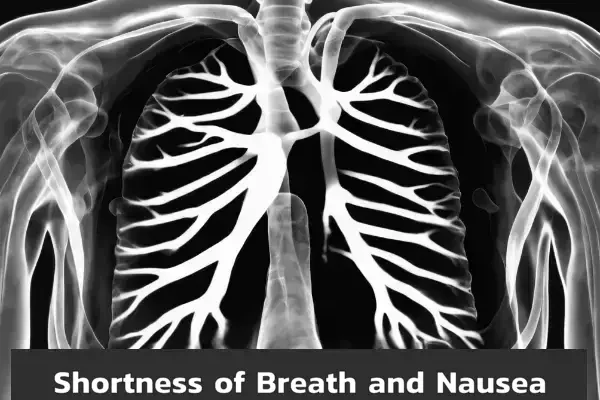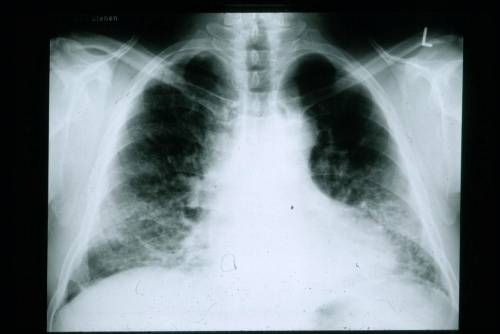Shortness of breath and nausea can occur together, which often indicates a serious medical condition. Possible causes include a heart attack, pulmonary embolism or a severe asthma attack.
If these symptoms appear suddenly and are accompanied by chest pain, sweating, or rapid heartbeat, you should seek medical attention immediately.
What is Shortness of Breath?
Dyspnea, which is also referred to as shortness of breath, occurs when someone has trouble breathing deeply or feels like they are not getting sufficient air into their lungs. This can also be accompanied by a feeling of tightness in the chest or rapid breathing. The severity of this condition can range from mild to severe and it can come on suddenly or develop gradually. Shortness of breath is often indicative of an underlying health problem and should be investigated by a medical professional.
Symptoms and possible causes
Shortness of breath can present itself as a challenge to breathe or a sense of not getting sufficient air. Several causes, including asthma, chronic obstructive pulmonary disease (COPD), and anxiety, can accompany this symptom. Conversely, nausea is the feeling of wanting to vomit and can be triggered by factors like gastrointestinal problems, viral infections, or medication side effects. It is crucial to take into account these symptoms and their potential causes to comprehend their connection.
Understanding Nausea
Nausea is an unpleasant feeling in the stomach that frequently leads to an urge to vomit. It is not a sickness on its own, but rather a sign of another issue. Nausea can be triggered by different things like infection, motion sickness, pregnancy, specific medications, or even psychological factors such as anxiety or stress. It is crucial to determine and deal with the root cause of nausea in order to properly handle this uncomfortable symptom.
Symptoms and possible causes
There are different ways in which shortness of breath can be experienced, like quick breathing, feeling a tightness in the chest, or feeling like there is not enough air. The reasons for this can vary, from underlying health conditions such as asthma or COPD, to environmental factors like pollution or changes in altitude. Other potential causes include anxiety, panic attacks, heart issues, or lung diseases. It is important to understand these symptoms and possible causes in order to determine the main issue and find the right treatment.
Causes of Shortness of Breath and Nausea
There are many reasons why someone may experience shortness of breath and feelings of nausea. Commonly, respiratory conditions, cardiac conditions, and other health conditions can be a factor. Conditions like asthma, chronic obstructive pulmonary disease, and pulmonary embolism can all result in these symptoms.
Additionally, heart failure, arrhythmia, and hypertension can also be responsible for these sensations.
Moreover, other health issues, including anxiety, kidney disease, and anemia, can contribute to both shortness of breath and nausea. It is vital to investigate the relationship between these symptoms and their underlying causes to ensure proper treatment is received.
Shortness of breath and feeling nauseous can be caused by various common conditions. Anxiety is one condition that can cause these symptoms, as the body’s reaction to stress can lead to a sense of breathlessness and queasiness. Another potential cause is kidney disease, which can result in the accumulation of waste products in the body due to impaired kidney function, leading to difficulty breathing and nausea.
Additionally, anemia, a condition marked by a deficiency of red blood cells or low hemoglobin levels, can also be responsible for both shortness of breath and nausea. These are just a few examples of the numerous conditions that can contribute to the presence of these symptoms.
Exploring the link
Studying the connection between breathlessness and feeling sick can offer important knowledge about what is causing these symptoms. Although there is no direct correlation between them, they often happen at the same time because of similar bodily processes or underlying health issues. Recognizing this link can aid medical professionals in accurately diagnosing and treating patients. It is crucial to further investigate to pinpoint how exactly they are related and determine potential ways to treat individuals facing both breathlessness and nausea.
Respiratory Conditions
Respiratory problems can have a significant impact on causing difficulty breathing and feeling nauseous. Conditions like asthma, chronic obstructive pulmonary disease (COPD), and pulmonary embolism can all be factors in causing these symptoms. Asthma involves inflammation and constriction of the airways, making it difficult to breathe. COPD gradually damages the lungs, leading to breathlessness. Pulmonary embolism occurs when a blood clot obstructs a lung artery, resulting in respiratory distress. Proper diagnosis and treatment are necessary for managing these conditions and improving overall respiratory function.
Shortness of breath and feeling nauseous can often be attributed to respiratory illnesses. Conditions like asthma, chronic obstructive pulmonary disease (COPD), and pulmonary embolism are common culprits for these symptoms. Asthma causes inflammation in the airways, making it challenging to breathe and possibly inducing nausea. COPD gradually narrows the airways, making breathing difficult. On the other hand, a pulmonary embolism occurs when a blood clot blocks the lung arteries, resulting in breathing difficulties and potential queasiness. It is crucial to promptly treat these respiratory conditions to alleviate the symptoms.
Asthma, Chronic Obstructive Pulmonary Disease (COPD), and pulmonary embolism are all respiratory conditions.
Respiratory conditions such as asthma, chronic obstructive pulmonary disease (COPD), and pulmonary embolism are frequently occurring and can lead to symptoms of breathlessness and a feeling of queasiness.
Asthma is a long-lasting illness characterized by swollen and narrow air passages, which makes it hard to breathe. COPD is a lung disease that worsens over time and includes chronic bronchitis and emphysema, causing airway restriction. Pulmonary embolism happens when a blood clot blocks a large lung blood vessel and leads to sudden difficulty in breathing and sometimes feeling sick.
Cardiac Conditions
Cardiac conditions are health problems that impact the heart and can result in symptoms like feeling out of breath and experiencing nausea. Heart failure occurs when the heart is unable to effectively pump blood, which can lead to fluid buildup in the lungs and difficulty breathing. Abnormal heart rhythms, known as arrhythmia, can disrupt the flow of blood and hinder oxygen delivery. High blood pressure, also called hypertension, can strain the heart and cause symptoms such as shortness of breath and nausea. If you have any concerns about your heart health and are experiencing these symptoms, it is crucial to seek medical help.
Issues related to the heart, such as cardiovascular problems, can result in symptoms like difficulty breathing and feeling dizzy or nauseous.
Symptoms like breathlessness and queasiness are often linked to cardiac conditions. When the heart cannot efficiently pump blood, it can cause the accumulation of fluid in the lungs, resulting in difficulty breathing and a feeling of being out of breath. Moreover, insufficient blood flow to the digestive system can lead to digestive problems such as nausea. Heart failure, arrhythmia, and hypertension are recognized as conditions that can contribute to these symptoms. If you consistently experience breathlessness and nausea, it is crucial to consult a medical professional as it may indicate an underlying heart problem.
Heart failure, arrhythmia, hypertension
Three cardiac conditions, including heart failure, arrhythmia, and hypertension, can cause symptoms such as shortness of breath and nausea. Heart failure occurs when the heart cannot effectively pump blood, which causes fluid buildup in the lungs and leads to breathlessness. Arrhythmia refers to abnormal heart rhythms that can disrupt blood flow and oxygen supply, resulting in symptoms like difficulty breathing. Hypertension, also known as high blood pressure, strains the heart and can cause symptoms like difficulty breathing and nausea. These conditions require medical treatment to address their root causes and relieve symptoms.
Other Causes
Aside from respiratory and cardiac ailments, there are numerous other health conditions that can cause breathlessness and queasiness. The body’s heightened stress response caused by anxiety disorders can lead to the manifestation of these symptoms. Kidney disease can also cause the accumulation of fluid, resulting in breathing difficulties and feelings of nausea. Anemia, characterized by a shortage of red blood cells, can reduce the delivery of oxygen to the body’s tissues, leading to both breathlessness and queasiness. If you encounter these symptoms, it is crucial to seek medical advice from a healthcare expert for an accurate diagnosis.
Anxiety, kidney disease, anemia
Shortness of breath and nausea can be caused by various health conditions such as anxiety, kidney disease, and anemia. Anxiety can lead to hyperventilation, causing difficulty in breathing and a sensation of sickness in the stomach. Kidney disease can result in fluid retention in the body, leading to respiratory problems and digestive issues. Anemia, which is characterized by a low red blood cell count, can cause oxygen deprivation and gastrointestinal problems. It is crucial to treat these underlying conditions in order to relieve symptoms of shortness of breath and nausea.
Treatment
There are various treatment options for shortness of breath and nausea. The treatment plan will vary depending on the root cause of these symptoms. Medications may be prescribed to relieve the symptoms and target the underlying issue. Making lifestyle changes like quitting smoking, staying at a healthy weight, and exercising regularly can also enhance respiratory and heart health. It is crucial to consult with a healthcare provider to determine the most effective treatment for your individual circumstance.
Various medical interventions are available to address feelings of breathing difficulties and sickness, ranging from pharmacological solutions to non-pharmacological approaches.
The treatment for shortness of breath and nausea varies depending on the root cause. If symptoms need to be managed and discomfort eased, medication may be prescribed. Respiratory conditions like asthma or COPD may require the use of inhalers or bronchodilators. Making lifestyle changes like quitting smoking or avoiding triggers can also help alleviate symptoms. It is crucial to consult with a healthcare provider to receive an accurate diagnosis and an appropriate treatment plan.
Medications, lifestyle changes
There are several choices for the treatment of shortness of breath and nausea. Doctors can prescribe medications to relieve symptoms and target the root cause. For instance, bronchodilators can be given for respiratory issues such as asthma, while diuretics may be used to handle fluid accumulation in heart failure. Apart from medications, lifestyle modifications also have a significant impact on managing these symptoms. These changes can involve quitting smoking, adopting a healthy diet, regularly engaging in physical activity, reducing stress levels, and managing any underlying medical conditions. Implementing these positive changes can enhance overall health and decrease occurrences of shortness of breath and nausea.
Conclusion
Feeling out of breath and experiencing an upset stomach can have various reasons, such as issues with the respiratory system, heart problems, or other health issues. If these symptoms persist or become severe, seeking medical assistance is crucial. Treatment for shortness of breath and nausea may involve taking medications and making changes to one’s lifestyle. Identifying the root causes can aid in determining the right course of treatment and enhancing overall health and wellness.
When someone feels breathless and nauseous at the same time, it could mean something is wrong with their health. It’s crucial to ask a doctor for help if these symptoms happen. It could be a sign of a severe issue with the heart or lungs. It’s suggested that people have check-ups regularly, live a healthy lifestyle, and stick to their treatment plans if they have any ongoing medical problems. Remember to talk to a healthcare professional for personalized advice and help.
When to seek medical help
It is essential to be aware of your body and recognize when to seek medical help if you are feeling short of breath and nauseous. If these symptoms are intense, persistent, or if you also have chest pain or feel lightheaded, it is crucial to seek immediate medical attention. Furthermore, if you have a long-term condition like asthma or heart disease and notice a sudden worsening of symptoms, it is wise to consult your healthcare provider. Quick medical intervention can identify and treat any underlying conditions that might be causing your discomfort.









